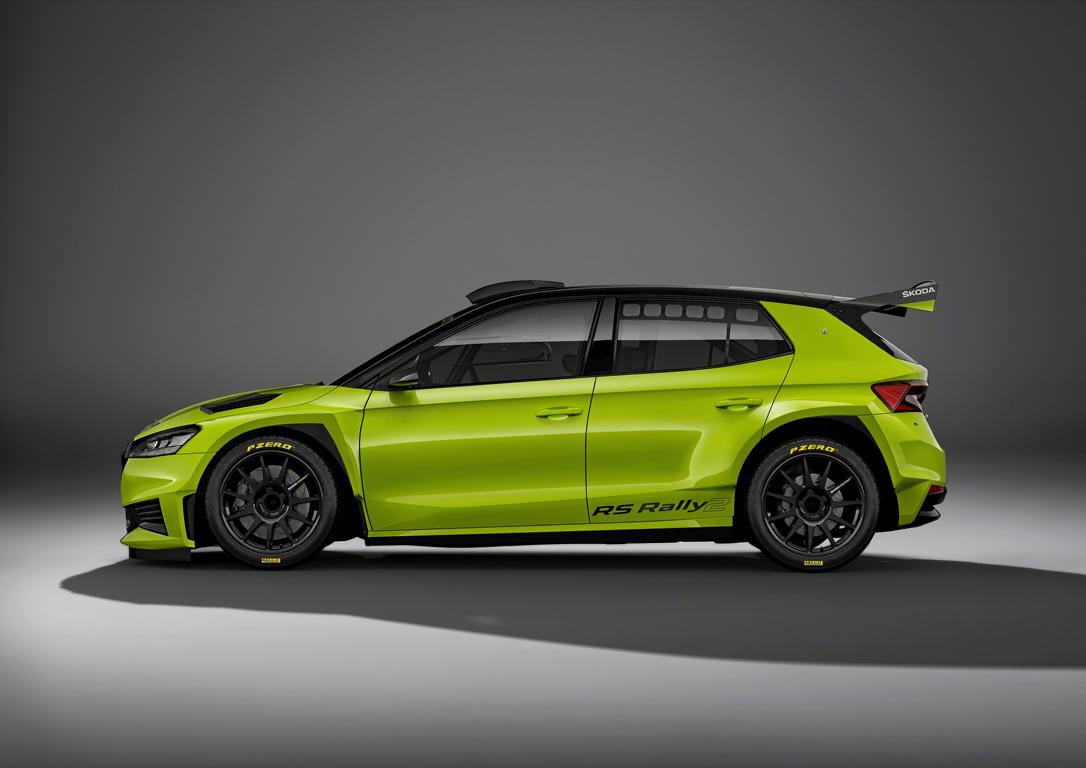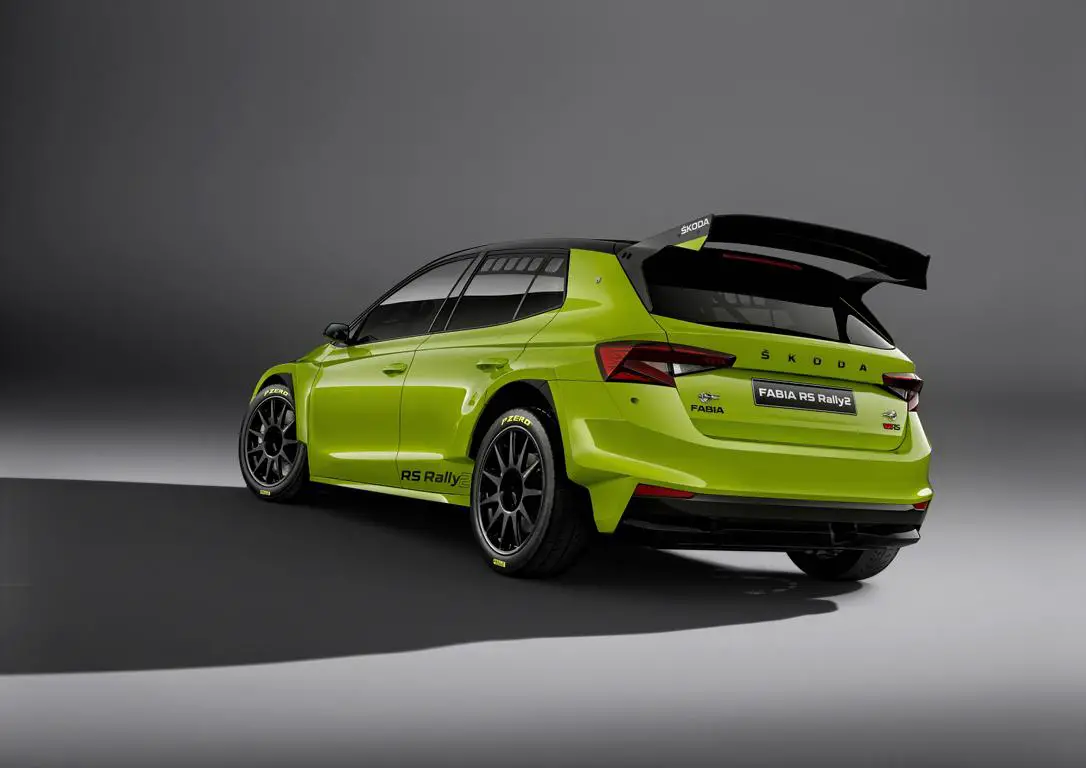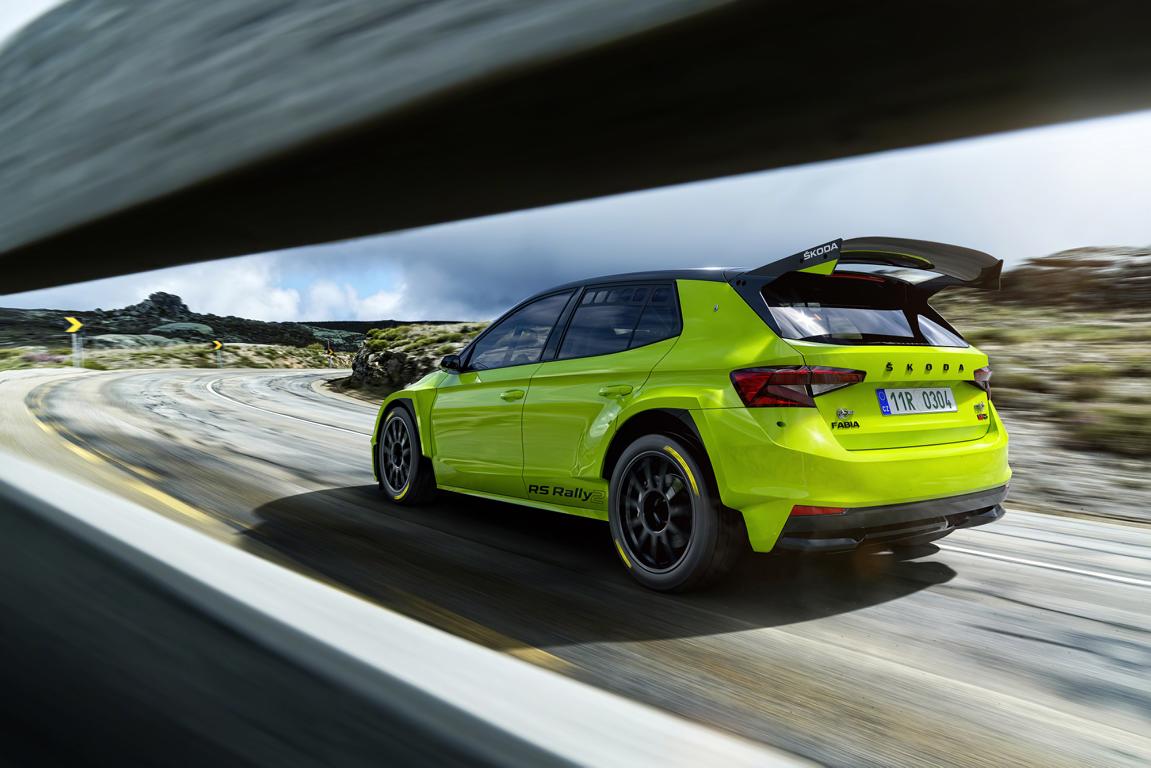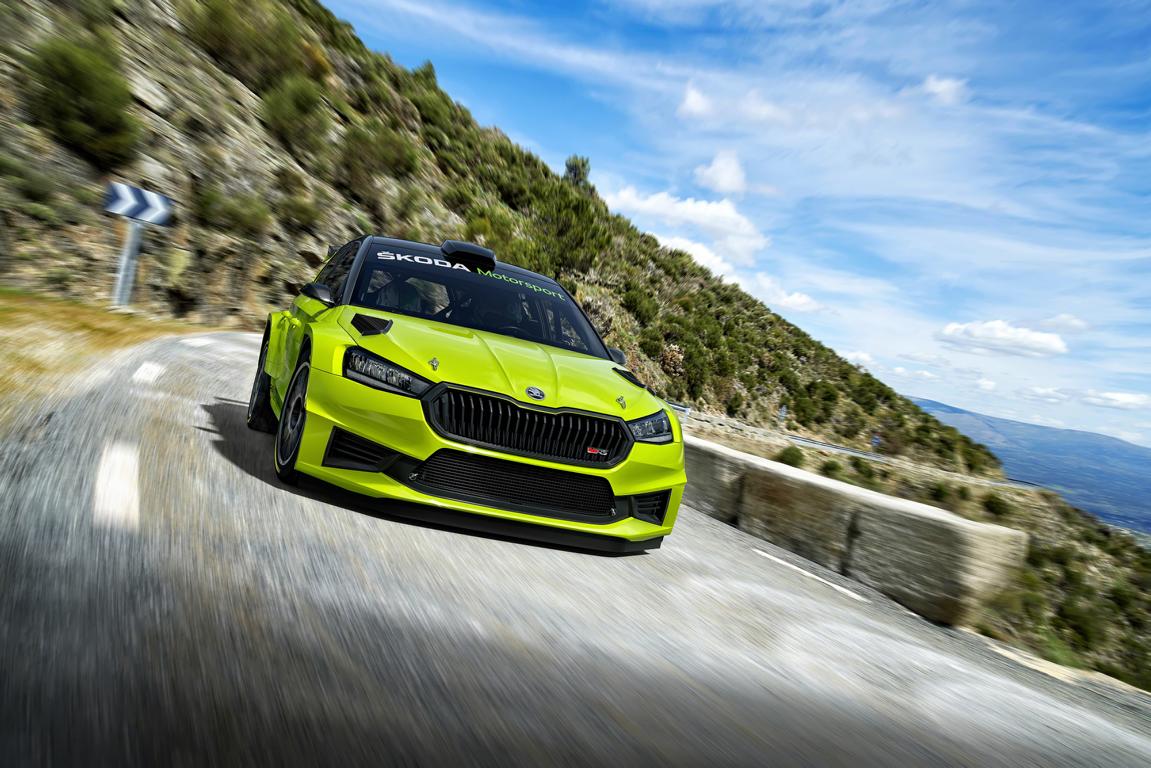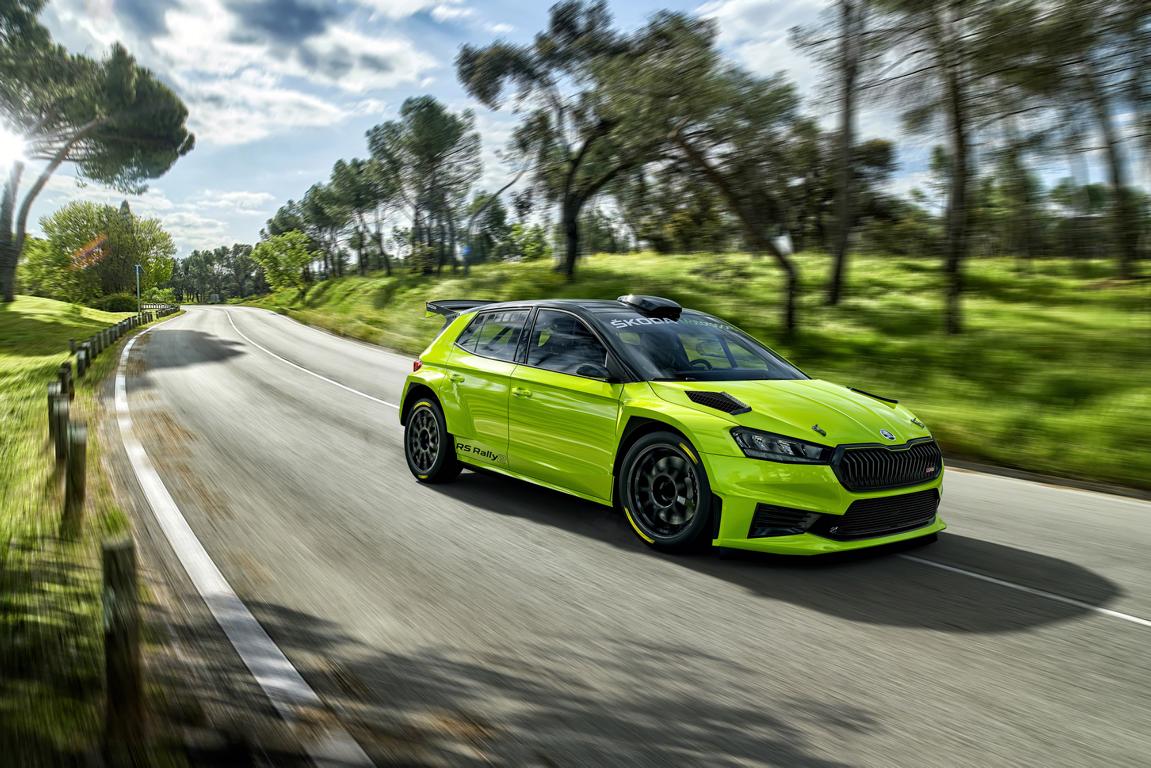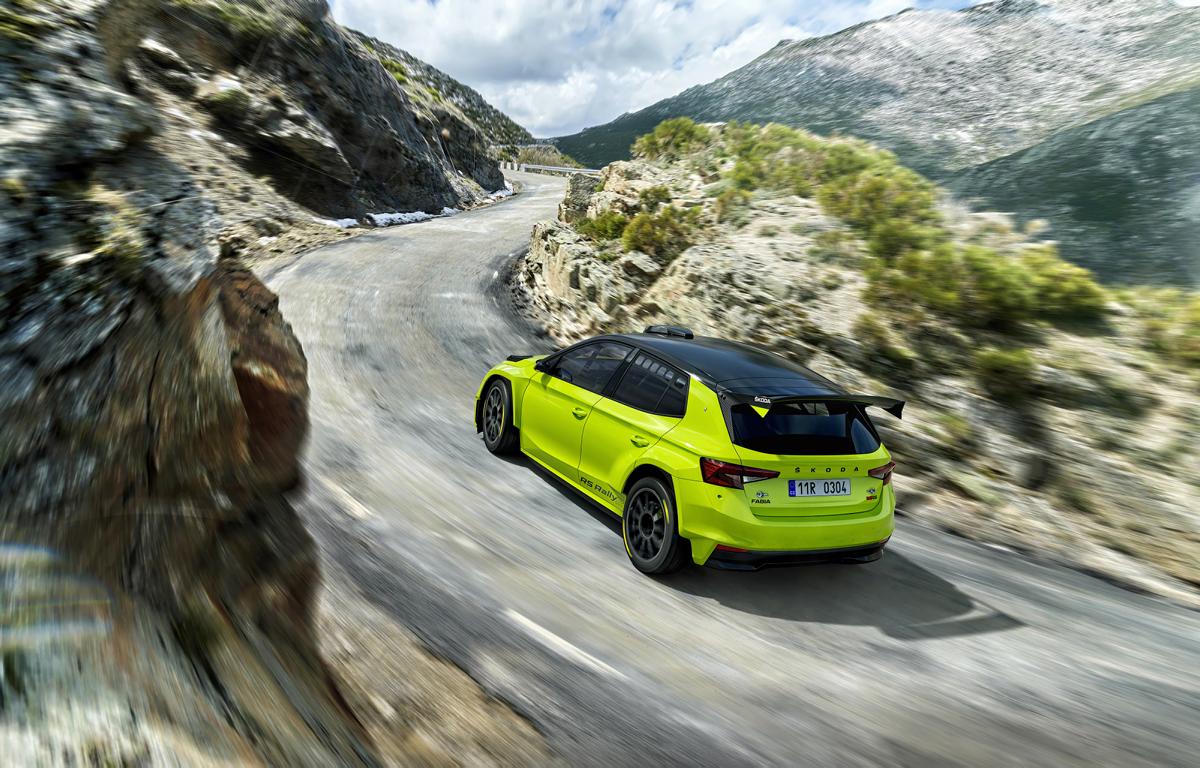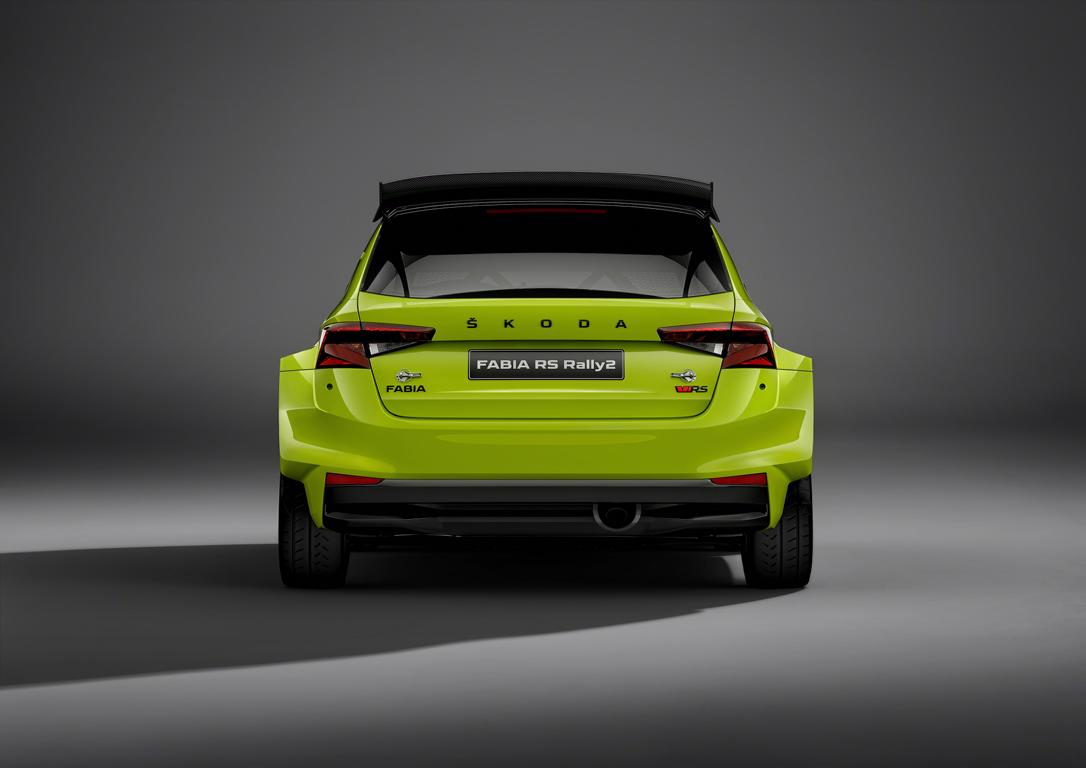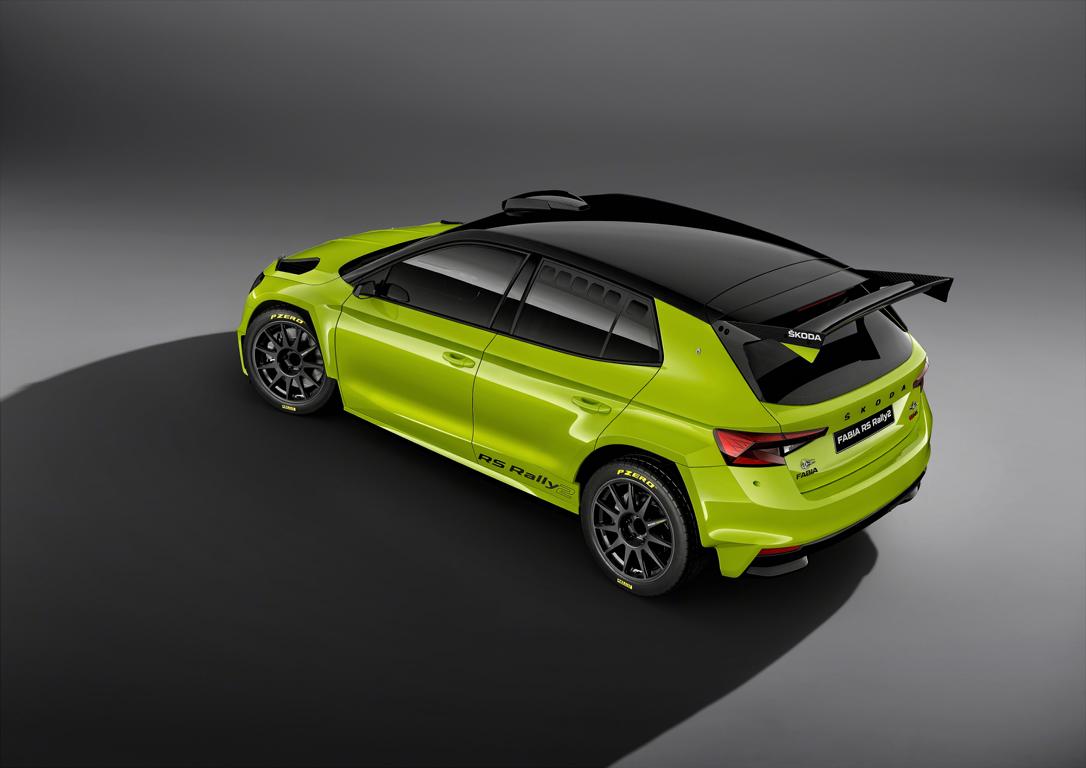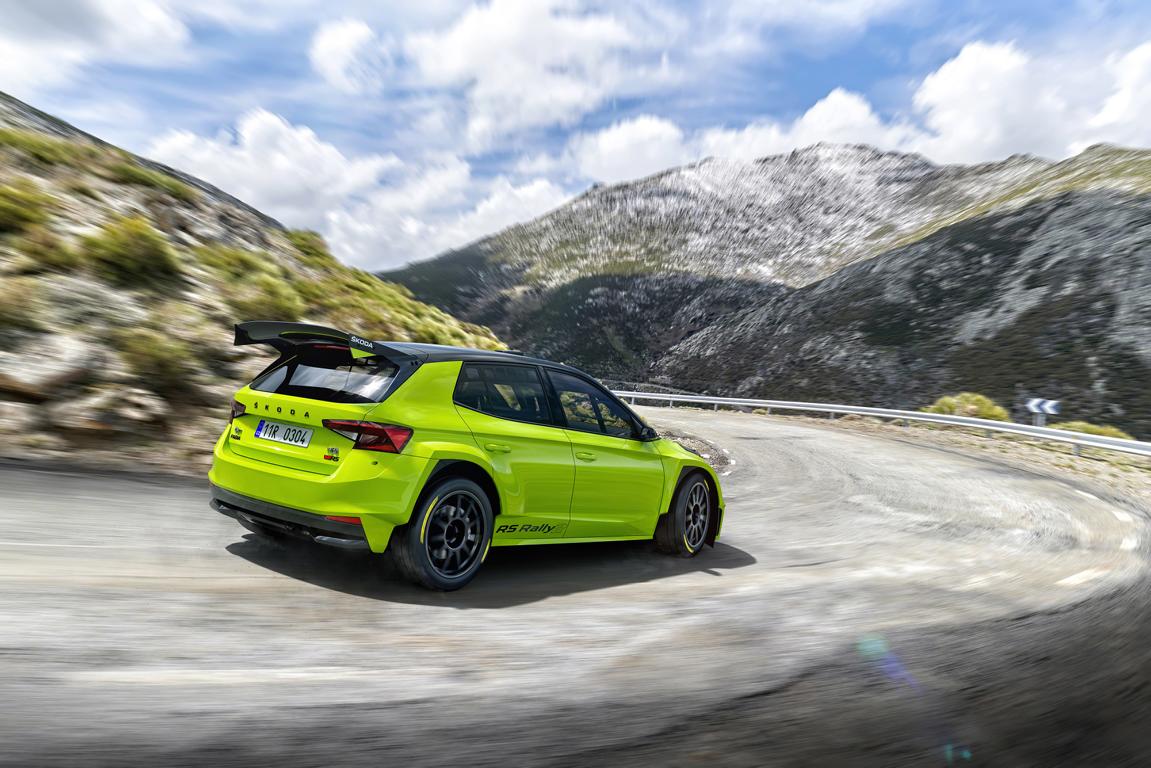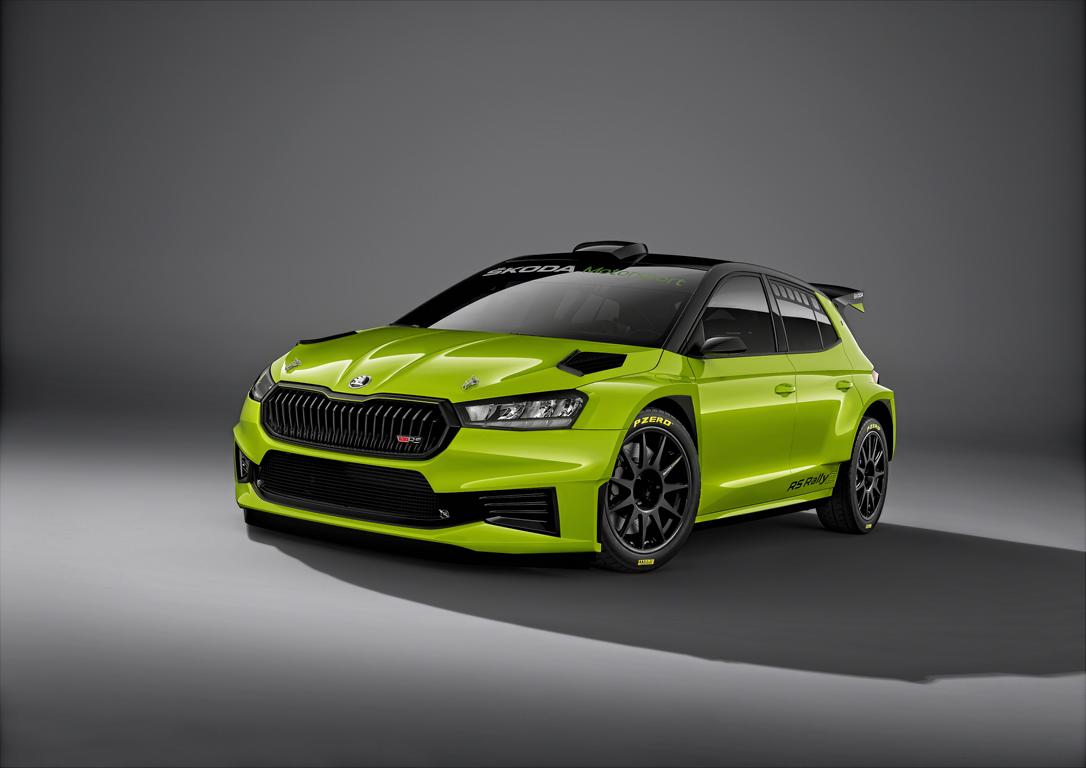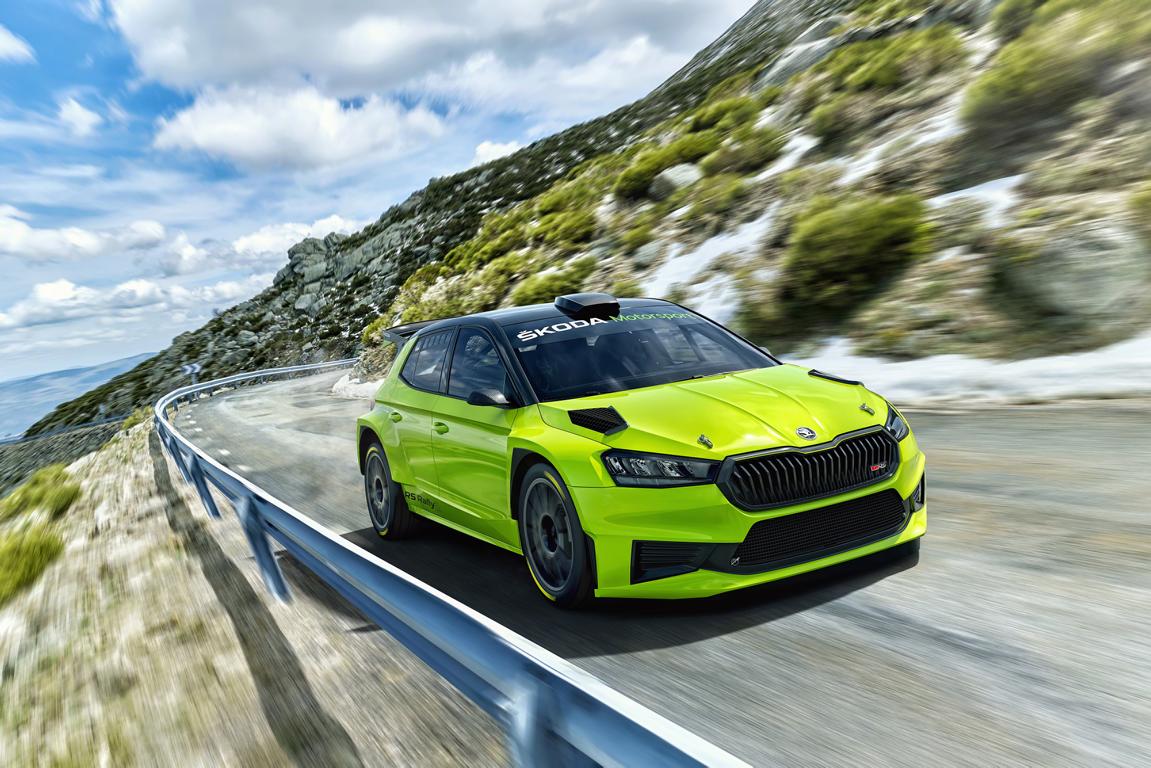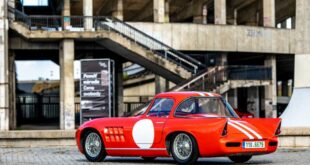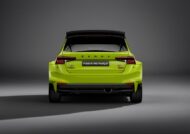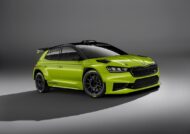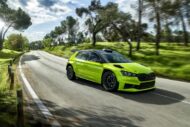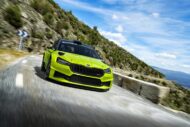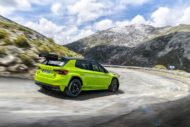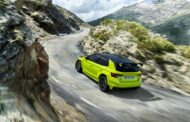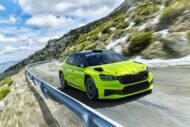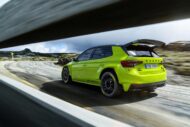for the new ŠKODA FABIA RS Rally2: ŠKODA Motorsport presents the successor to the FABIA Rally2 evo. The new rally model from Mladá Boleslav is based on the fourth generation of the ŠKODA FABIA and succeeds the most successful Rally2 vehicle of recent years. For the FABIA RS Rally2, ŠKODA Motorsport has developed a new engine, worked on the handling, powertrain and electronics, and further improved safety for the driver and front passenger. The new FABIA RS Rally2 has proven itself as part of a demanding test program on asphalt, gravel and ice as well as in different weather conditions and is optimally equipped to achieve victories and titles in the hands of customer teams in the future.
ŠKODA FABIA RS Rally2
Michal Hrabánek, Head of ŠKODA Motorsport, says: “Standing still means going backwards, and that’s especially true in motorsport. Therefore, when developing the new FABIA RS Rally2, we used our experience that we gained with the previous model and optimized every detail. The aim was to further improve what is currently the most successful rally vehicle in the world. I'm proud of the entire ŠKODA Motorsport team, which got involved here with great enthusiasm. I would also like to thank our colleagues from series development: With the fourth-generation FABIA, we had the perfect basis for the FABIA RS Rally2.”
The completely newly developed ŠKODA FABIA RS Rally2 is a rally car for the Rally2 category and benefits from the best-in-class aerodynamics and the particularly rigid body of the production model. Compared to the successful predecessor, the ŠKODA Motorsport team optimized the powertrain, electronics, safety and handling in particular. The engineers also developed a new 1,6-liter turbo engine based on the 2,0 TSI from the EA888 engine series, which can be found in the RS models, among others. The new ŠKODA Motorsport paintwork points to the close connection with the sporty RS series models: the color mamba green is reminiscent of the OCTAVIA RS and the ENYAQ COUPÉ RS iV.
Demanding test program in different weather conditions
In order to optimally prepare the new ŠKODA FABIA RS Rally2 for its use on the rally track, ŠKODA Motorsport subjected it to extensive tests on asphalt, gravel and snow for almost a year. Since summer 2021, test drives in the Czech Republic, France, Italy, Croatia, Germany, Belgium and Spain as well as under extreme winter conditions in northern Finland have been on the program.
Overview: technical highlights of the new rally car
- Wider body and longer wheelbase ensure better weight distribution
- Motorsport brake system with particularly strong deceleration and efficient cooling
- Robust suspension components are designed for extreme requirements
- Safety cage made of 35,8 meters of tubular steel and specially protected tank
In the new FABIA RS Rally2, ŠKODA Motorsport relies on numerous components optimized for use in rallies. A special brake system and a particularly well-balanced chassis set-up save valuable tenths of a second on the track. The safety cage made from a total of 35,8 meters of tubular steel and a specially protected fuel tank ensure a high level of safety on board. The electronics and the controls meet the exact requirements of the driver and co-driver during a rally.
Some of the components used in rally vehicles differ significantly from their counterparts in production vehicles. Instead of up to nine airbags and numerous electronic assistance systems as in the production FABIA, the new ŠKODA FABIA RS Rally2 relies on pure mechanics in many areas. There are also special components on board, such as a safety cage and a specially protected fuel tank. Unlike a production FABIA, the rally version only uses sensors for engine control and for displaying brake pressure, steering wheel position and fuel level. The sensors only serve to provide information; unlike in the production model, they do not take on any control functions. Only the engine control unit uses sensor data to ensure that the engine works optimally in all driving modes and in different weather conditions.
Different front axle brake discs for asphalt and gravel tests
In a rally vehicle, the braking system saves valuable tenths of a second in the race against the clock. The greater the deceleration, the later the driver can brake into a corner. During hard braking manoeuvres, the brake discs can easily reach temperatures of more than 700 degrees Celsius. To ensure efficient cooling at all times, the brake discs of the FABIA RS Rally2 are internally ventilated, and there is also an optimized brake cooling system for gravel and asphalt tests. The brake discs for testing on asphalt have a diameter of 355 millimeters at the front and 300 millimeters at the rear. 18-inch wheels with rim size 8×18 are specified here. The brakes for use on gravel measure 300 millimeters at the front and rear, and 15-inch wheels in size 7×15 are used here.
Special fuel tank for XNUMX% sustainable petrol or for fossil racing fuel
The FABIA RS Rally2 has a special fuel tank made of impact-resistant rubber in accordance with the regulations of the international automobile association FIA. The volume is 82,5 liters. A special foam filling prevents petrol from leaking out. A cover made of a carbon-kevlar composite and an absorbent layer on the underside provide further protection. In the 2022 season, the FIA World Rally Championship (WRC) will use 100 percent sustainable fuel based on modern raw materials and high-purity renewable components.
The biofuels are obtained from biological waste and synthetic e-fuels. These e-fuels are obtained through the use of renewable energies, which enable electrolysis from 'green' hydrogen and CO2, which is extracted from the air and industrial processes. A 100 percent renewable gasoline without fossil components is then mixed in the laboratory.
35,8 meters of tubular steel protect the crew
The engineers at ŠKODA Motorsport have developed a safety cage for the new FABIA RS Rally2, which consists of a total of 35,8 meters of high-strength chrome-molybdenum steel tubes and is welded to the chassis during body construction. Only then are the side parts and roof mounted. This approach enables even greater manufacturing precision and better adaptation and connection with the body.
Specific rally chassis and longer service lives of the components
The chassis of the FABIA RS Rally2 is also consistently designed for the requirements of rallying. Compared to the previous model, the suspension stroke of the dampers is now longer and the stiffness of the MacPherson struts is higher. The engineers also reduced the friction in the dampers. Due to the longer wheelbase, they also designed new chassis kinematics. In addition to the design of the differential, the shifting behavior of the transmission and the durability of various components have also been optimized.
Simple operation via touchpad and steering wheel buttons
An enlarged main display, on which video information can even be played, enables intuitive operation in the FABIA RS Rally2 during a rally. There is also a new central control panel with touchscreen and integrated intercom in the interior. The driver can call up numerous functions directly via buttons on the steering wheel. The button for starting the engine is also on the steering wheel and can be reached quickly if, for example, the engine stalls after a spin.
Better weight distribution thanks to wider body and longer wheelbase
The chassis based on the current generation of the ŠKODA FABIA production model gave the engineers the opportunity to further optimize the handling characteristics of the rally car. The FABIA RS Rally2 benefits in particular from the longer wheelbase of the fourth FABIA generation, which makes the car quieter and at the same time ensures a more stable rear. Compared to the ŠKODA FABIA Rally2, the fuel tank has been repositioned and the additional space in the engine compartment has been used for a larger intercooler, for example.
Drive: newly developed turbo engine, sequential gearbox and all-wheel drive
- ŠKODA FABIA RS Rally2 has a new engine with around 214 kW (289 hp) based on the 2,0 TSI from the EA888 engine series
- Sequential 5-speed transmission enables gear changes within a few milliseconds
- The separating clutch between the front and rear axles is now actuated hydraulically
ŠKODA Motorsport has developed a new engine for the FABIA RS Rally2 and further optimized the proven powertrain. The 1,6 liter turbo engine of the FABIA RS Rally2 is based on the 2,0 TSI from the EA888 engine series and has an output of around 214 kW (289 hp). The maximum torque of 430 Nm is distributed to all four wheels via a sequential 5-speed gearbox and two differentials.
The Rally2 regulations of the International Automobile Federation (FIA) stipulate a 1,6-liter turbo engine based on a production engine for vehicles in this category. When developing the unit for the new ŠKODA FABIA RS Rally2, ŠKODA Motorsport relied on the 2,0 TSI with an integrated exhaust manifold from the EA888 engine series, which is used in the RS models, among other things. Compared to the engine of the FABIA Rally2 evo, the newly developed four-cylinder has newly designed intake and exhaust ports, optimized pistons and combustion chambers, variable valve control and a newly designed lubrication system for a significantly better combustion process. The engineers also revised the exhaust system, which has a new turbocharger, and developed a new intercooler and a cooling circuit with higher cooling capacity. The FABIA RS Rally2 also has new engine management software. According to the technical FIA regulations for the Rally2 category, the diameter of the air restrictor is 32 millimetres. The round engine thus delivers 214 kW (289 hp) and the maximum torque is 430 Nm.
Power is transmitted to all four wheels via a 5-speed gearbox and two differentials
The sequential 5-speed gearbox, specially designed for use in rallies, allows the driver to change gears within a few milliseconds simply by operating the shift lever. Although the FABIA RS Rally2 has a mechanical clutch, it is only used for starting, parking or when driving slowly. For optimal acceleration on tight, winding rally stages, the FABIA RS Rally2 has a relatively short gear ratio that enables a top speed of around 200 km/h.
The drive concept of the FABIA RS Rally2 differs significantly from the production model, not least because of the all-wheel drive. Since the technical rules of the FIA exclude the use of electronic driving aids to improve traction, only mechanical differential locks on the front and rear axles are permitted, an additional center differential is not permitted. The separating clutch between the front and rear axles, which is actuated when the handbrake is pulled, supports cornering on the rally track. On the chassis side, MacPherson struts are used on both axles, which are designed for extreme loads.
Design and aerodynamics: series model as the perfect basis
- FABIA RS Rally2 benefits from the class-leading aerodynamics of the fourth FABIA generation
- Downforce almost doubled compared to the previous model
- Emotional design language, paintwork in the RS color mamba green
The new ŠKODA FABIA RS Rally2 brings the emotive design language of the fourth FABIA generation to international racing circuits. The new rally vehicle benefits from the aerodynamics of the production model. ŠKODA Motorsport developed a highly efficient aerodynamics package based on the FABIA's best-in-class drag coefficient. As a result, the new FABIA RS Rally2 generates almost twice as much downforce as its predecessor. The new ŠKODA Motorsport paintwork in mamba green creates a link to the sporty RS series models OCTAVIA RS and ENYAQ COUPÉ RS iV.
The new rally model FABIA RS Rally2 transfers the design language of the fourth FABIA generation to motorsport. In addition to the longer roof spoiler with side finlets, the rally model also has the flat, sharply drawn front headlights of the production vehicle, which reach up to the large, hexagonal ŠKODA grille. Headlights and rear lights with LED technology set visual accents, and the rally FABIA also differs from its series counterpart at first glance with significantly wider fenders at the front and rear and numerous air outlets on the body. The paint finish in mamba green refers to the ŠKODA RS family and is reminiscent of the OCTAVIA RS and the ENYAQ COUPÉ RS iV.
Downforce values almost doubled
The production version of the ŠKODA FABIA has the best drag coefficient in its class. The experts from ŠKODA Motorsport used these perfect conditions when developing the aerodynamics package for the FABIA RS Rally2. Thanks to intensive detailed work, it has been possible to almost double the downforce compared to the predecessor - an enormous advantage on the track, because higher downforce enables higher cornering speeds. For regulatory reasons, the engineers had to do without the use of active aerodynamic parts such as the radiator shutters from the production FABIA.
Lukáš Vojík, aerodynamics expert from Technical Development at ŠKODA AUTO, explains: “Some aerodynamically relevant elements of the production model have also proven themselves in the rally car. We paid even more attention to aerodynamics than on the predecessor and looked closely at every detail. Our goal: higher downforce for higher cornering speeds and better handling while at the same time making the vehicle even more aerodynamically efficient.”
The air curtains in the front bumpers of the production FABIA guide the airflow narrowly and aerodynamically particularly well past the body and wheels and are also used in the FABIA RS Rally2. In combination with the new side skirts, which prevent air from flowing under the vehicle from the side, they also increase downforce. With a front splitter across the entire lower edge of the front bumper, they ensure optimal aerodynamic efficiency of the front section. The splitter also reduces the amount of air going under the vehicle. This ensures faster airflow and lower pressure under the vehicle, which increases downforce.
Typical aerodynamic components for a rally car
Numerous aerodynamic components have been specially developed for the FABIA RS Rally2. In addition to the wider fenders at the front and rear, the newly developed rear wing increases downforce. Dimensions and position correspond to the regulations for vehicle width and height. A small spoiler lip, a so-called Gurney flap, serves as a spoiler lip and also improves downforce. The air flow over the roof is optimized by a centrally placed air scoop, which at the same time directs fresh air into the cockpit. On a production vehicle, this air intake is located below the windshield, but on rally cars, this area of the vehicle is very susceptible to dust or water.
Cooling air for engine and brakes
In racing, the engine and brakes require more cooling air, which the FABIA RS Rally2 supplies via special aerodynamic components. Fresh air for the water cooler is fed into the upper area of the engine compartment and to the intercooler of the turbocharger, which is located further down, via two large, central air inlets at the front. The hot air is discharged through openings on both sides of the bonnet. Cooling air also reaches the front brake calipers directly via two inlets in the front apron and small ventilation pipes.
Safety: even better protection for driver and front passenger
- Safety equipment of the Rally2 vehicle exceeds the strict requirements of the FIA technical regulations
- Carbon fiber, Kevlar and energy absorbing foam side impact protection
The engineers at ŠKODA Motorsport have taken numerous measures to protect the driver and front passenger in the FABIA RS Rally2 even better in the event of a collision. The focus was particularly on safety in the event of a side impact. Extensive accident analyzes provided important information.
The measures and devices for occupant protection in a rally vehicle differ significantly from a production model. The airbags of the fourth-generation series FABIA cannot be used in rallying because the sensors and electronic control systems react too sensitively to the high G-forces on asphalt tests, on gravel roads or over long jumps. The safety concept therefore relies on mechanical solutions such as a roll cage or side protection made of carbon fiber and energy-absorbing foam. There are also six-point belts and racing seats with integrated head protection.
Roll cage made of high-strength chrome-molybdenum steel
When designing the new model, the engineers at ŠKODA Motorsport used analysis data from previous rally accidents. The roll cage of the new FABIA RS Rally2 made of 35,8 meters of high-strength chrome-molybdenum steel consists of longitudinal, transverse and diagonal tubes in the door openings, under the vehicle roof, around the windscreen and behind the seats. The dimensions and material of the safety cell are determined by the technical regulations of the International Automobile Federation (FIA). ŠKODA Motorsport clearly exceeds these requirements with the new rally FABIA. The gusset plates that are relevant in the event of a side impact are also designed to be more robust than specified.
The roll cage, designed with the help of computer calculations, ensures that the driver and front passenger have enough space to survive in the event of an accident, even if the body is severely deformed. It is also an integral part of the chassis, to which it is hand-welded by certified experts. This significantly increases the torsional rigidity of the body, which is already stiffer due to the use of the MQB-A0 platform. Every FABIA RS Rally2 is assembled exclusively at ŠKODA Motorsport in Mladá Boleslav.
Carbon fiber, Kevlar and energy absorbing foam side impact protection
In a rally vehicle, the driver and front passenger are particularly at risk in the event of a side impact. While a combination of B-pillars, door reinforcements and airbags provide protection in the production FABIA, the rally version is primarily ensured by the roll cage with two door pillars and gusset plates. In addition, the FABIA RS Rally2 has an energy-absorbing structure made of foam between the outer skin of the door and the interior, as well as door panels made of composite materials. The structure of the composite panels is predetermined: five layers of carbon 280 and one layer of Kevlar 300. The Kevlar layer is closest to the driver and passenger and protects them from sharp-edged carbon splinters in the event of an accident.
The absorbent foam must be approved by the FIA and have a minimum volume specified in the regulations in order to reduce the impact energy and thus the stress on the human body. In the FABIA RS Rally2, specific racing seats, six-point harnesses and personal equipment such as the mandatory head-and-neck support system (HANS) on the helmet with straps also help to effectively reduce the forces acting on it. This system protects the crew from rapid and violent head movements.
In order to better distribute the forces that occur in a side impact, both sides of the body of the FABIA RS Rally2 are connected to each other by the structure of the seat brackets and an additional rail. The door crosses of the roll cage are also designed to be even more robust and exceed the FIA requirements. To further optimize the strength of the shoulder strap attachment points, the FABIA RS Rally2 received an additional cage tube on each side of the vehicle.
Automatic fire extinguishing system on board
The FABIA RS Rally2's polycarbonate side windows are easily removable in accordance with FIA regulations. Safety equipment on board also includes a fire extinguishing system, which includes an automatic system with nozzles in the cockpit and engine compartment and a manual extinguisher in the passenger's footwell. The system can be activated from inside and outside.
Don't worry, of course that was far from being the case when it came to auto / auto tuning. Our magazine still has tens of thousands other tuning reports in stock. Do you want to see them all? Then just click HERE and look around. Or are you particularly interested in everything to do with vehicles of the Skoda brand? Then click on one of the following posts!
other related posts
|
Power Skoda with racing car potential: Yeti with almost 500 hp! |
|
|
Eco driving fun update: H&R sport springs for the Skoda Enyaq! |
 tuningblog.eu Your magazine about tuning the car
tuningblog.eu Your magazine about tuning the car

